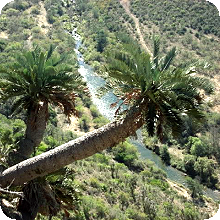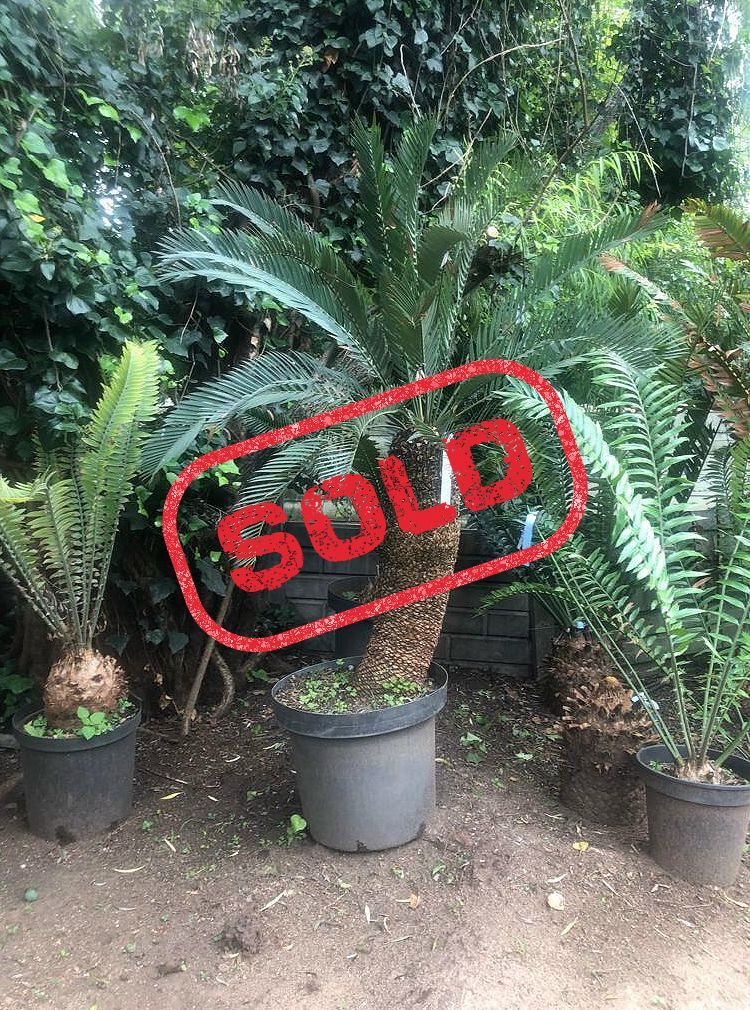| |||
| Division: Cycadophyta |
| Class: Cycadopsida |
| Order: Cycadales |
| Family: Zamiaceae |
| Genus: Encephalartos |
| Species: E. princeps |
Conservation Status: |

E. princeps
Kei CycadEncephalartos princeps, also known as the Kei cycad (Eng.); keibroodboom (Afr.); umguza, umphanga (Xhosa), is a lovely blue-leaved cycad that is restricted to the catchment area of the Great Kei River (Eastern Cape). The plants grow in riverine scrub between rocks and on doleritic cliffs. The annual rainfall in its distribution area ranges from 420-520 mm, with hot summers and cool winters.
It is a woody plant with about 10-15 aerial, erect stems that form a cluster, though the stems may sometimes recline or lie flat on the ground. The stems may develop to a height of up to 5 m and a diameter of 300-400 mm.
The leaves are 120-200 mm long, straight but curving downwards at the apex. They are blue-green with a silvery bloom when still young, but darken slightly with age. The median leaflets attain a length of up to 120-150 mm and a width of 10-13 mm. The leaflets at the base are reduced in size, and have one or two spines at the most.
Male and female plants bear 1-3 dull green cones per season per stem. The cones are produced in January, with the male cone shedding pollen during April-June, and the female cones starting to break up during October-December.
Cultivation:
Encephalartos princeps is an adaptable plant well suited to warm, temperate and subtropical climates, and can handle light frosts. With its bright foliage heightened by full sun, it is a commanding accent plant in the general landscape and makes an excellent tubbed specimen
It can be grown in full sun without its leaves burning. Its colour makes it a good subject for the nightscape. Its beauty and ease of horticulture make it one of the finest cycads for use in the garden. It is partially drought tolerant and wind tolerant.
As a garden plant, this cycad will usually hold one or two crowns of leaves, all in good condition. As a seedling, it often loses its previous year's leaves before the new leaves emerge. The seedlings need plenty of room for the tap root to develop and require very good drainage.
Growth rate: It is a long lived slow growing plant taking 15 to 20 years for one of these to produce a cone, so patience is a must.
Soils: It responds well to deep, fertile, slightly acidic, well drained, soil enriched with compost.
Watering: In cultivation prefers plenty of water, especially in dry weather for optimal growth. But it is eventually drought resistant.
Fertilization: Naturally undemanding for nutrients, it responds very well to regular applications of fertilizer. Growth can be greatly improved through the application of fertilizers. Most growers find that a fertilizer having an even NPK (Nitrogen, Phosphorus, Potassium) balance, and supplemental trace elements, provides a good start for cycads.
Exposure: It will grow in sun or partial shade, however best results are obtained growing the seedlings in full sun.
Hardiness: They do best in a tropical or sub-tropical climate and should be kept totally dry in winter at or around 10°C but demonstrate a remarkable degree of cold resistance and may tolerate light frost for short periods if dry, however heavy frosts would probably be fatal.
Propagation: Plants are not readily available from nurseries, however they are also easy to propagate from seeds. They can also be propagated from suckers with some patience and experience.
| full sun | blue | very low watering | slow growth | frost-hardy | uncommon |
Encephalartos princeps is an adaptable plant well suited to warm, temperate and subtropical climates, and can handle light frosts. With its bright foliage heightened by full sun, it is a commanding accent plant in the general landscape and makes an excellent tubbed specimen
It can be grown in full sun without its leaves burning. Its colour makes it a good subject for the nightscape. Its beauty and ease of horticulture make it one of the finest cycads for use in the garden. It is partially drought tolerant and wind tolerant.
As a garden plant, this cycad will usually hold one or two crowns of leaves, all in good condition. As a seedling, it often loses its previous year's leaves before the new leaves emerge. The seedlings need plenty of room for the tap root to develop and require very good drainage.
Growth rate: It is a long lived slow growing plant taking 15 to 20 years for one of these to produce a cone, so patience is a must.
Soils: It responds well to deep, fertile, slightly acidic, well drained, soil enriched with compost.
Watering: In cultivation prefers plenty of water, especially in dry weather for optimal growth. But it is eventually drought resistant.
Fertilization: Naturally undemanding for nutrients, it responds very well to regular applications of fertilizer. Growth can be greatly improved through the application of fertilizers. Most growers find that a fertilizer having an even NPK (Nitrogen, Phosphorus, Potassium) balance, and supplemental trace elements, provides a good start for cycads.
Exposure: It will grow in sun or partial shade, however best results are obtained growing the seedlings in full sun.
Hardiness: They do best in a tropical or sub-tropical climate and should be kept totally dry in winter at or around 10°C but demonstrate a remarkable degree of cold resistance and may tolerate light frost for short periods if dry, however heavy frosts would probably be fatal.
Propagation: Plants are not readily available from nurseries, however they are also easy to propagate from seeds. They can also be propagated from suckers with some patience and experience.
Available E. princeps at Africa Cycads:
|
|
|



